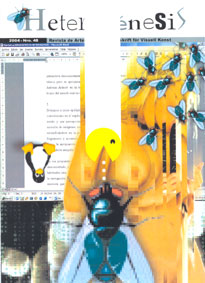|
Los sueños de Nezaket Ekici |
 |
|
| The dreams of Nezaket Ekici | ||
|
HANS
T STERNUDD
|
||
| Nezaket Ekici
Fountain, Korsväg Riddarhyttan, 2:a Korsvägssymposiet 5 juni
2004 En levande fontän där vattnet porlade ur aktörens dräkt som bestod av 77 påsar avsedda för urin. Under den ca. 20 minuter långa föreställningen framträdde den kvinnliga kroppen mer och mer i takt med att vattnet flödade ut i blåa hinkar ställda under piedestalen. |
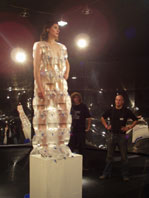
|
It’s like a nightmare to watch the German/Turkish action I had a Dream …. For three hours she’s acting or rather personifying the “human lawn mower-machine”, cutting grass with her teeth. Lying on her knees like someone praying, turned to Mecca with her behind up in the air, she systematically works her way forward to the end of the lawn, fifteen meters away. In the beginning the energy is very aggressive and effective, reminding you of the little angry girl called Little My in Tove Janssons Moominland, but as the action develops and energy is lost she gets slower and slower, and has to take long pauses to catch the air. This is tough work, this is for real. The title I had a dream... comes from a dream which I dreamt a long time ago. In this dream I saw a huge green field and I sat there and begun to cut the lawn with my teeth. When I woke up I was very tired and had a lot of taste from this lawn in my mouth. Ekici is a student of Marina Abramovic and some of the power of the dream-performance might have been developed through Abramovic’s training methods. I had a Dream … has been performed three times before. This time the scene is the cellar of Fyns Exhibition House and the act is a part of the 4th International Performance Festival Odense (Sept. 2003). Ekici performs her hardcore action in a simple set-up with only one spotlight in the end of a grass string that runs diagonally through the room. Next to the light a video camera is documenting Ekici’s work. The image from the camera is shown on a monitor placed in a room upstairs. When I talk with Ekici the day after the performance, at an outdoor cafe over a cup of tea, she says that one interesting thing with the video setup is to emphasize the difference between a live action and how limited the experience is if you watch it on a TV-screen. The monitor lacks sensations from senses aside from the ears and the eyes, Ekici says. This is so true. When you watch the human lawn mover-machine live, what touches you is the struggle of the artist, to hear her heavy breathings, her small screams when she spits out and her deep sighs of exhaustion. You smell the fragrance of the grass cutting that fills the room, the feeling of damp air and occasionally some pieces of grass that she spits out on you (if you’re close enough). You’re getting very impressed and also terrified. The scene is absurd in a Beckettian tradition, the contrast between Ekici dressed in a correct business-dress with white blouse and high-heel shoes and her mouth full of green straws, spitting and sputtering with a face that’s getting more and more green is striking. –Sometimes I rinse my mouth during the act and spit out the water on the lawn and become a fountain, she tells me. After two hours her energy begins to vanish, she gets more and more exhausted and the tears are not far away. This experience of seeing someone suffer is really touching. Nezaket Ekici points out the fact that it’s a very serious decision to use pain and suffering on stage. It’s very important to be respectful to the audience and not expose them to scenes they can’t cope with. Ekici says the she’s getting tired of doing these kind of brutal acts and foresees that her work is taking a new direction. The day after such a strong work, with the body aching and wounded from the hard grass on her nose and chin this feeling is easy to understand. What makes the artist continue doing something so painful when their whole body, every cell of it is screaming: – Stop this! – Get the hell out of here!. She doesn’t answer. Maybe there is something you must do, I think, that has to be done and it’s the artist’s task to do it. Like the shamans in old societies.
|
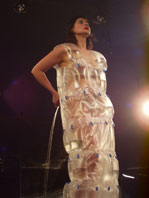 |
|
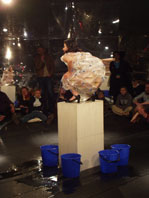 |
|
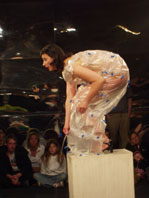 |
|
| The
dichotomy of the dream action (nice dress vs. absurd activities etc.)
is reflected in Ekici’s personal background. Despite the fact that
she’s been living in Germany for thirty years (since she was three),
she still feels as part of two cultures. Not fully accepted by any of
them. “In my work I want to explore the consequences of living in
two cultures, the problematic situations as many of the second generations
of immigrants are experiencing”, she explains. This theme is discussed
in works like The Turkish Picnic, in witch a typical picnic so popular
by Turkish immigrants in Germany was executed in a gallery. Two carpets
with one Turk family on each and a free carpet for the audience to sit
on and share the meal. She’s also done a piece in which traditional
eastern belly-dancing is mixed with a western hula-hoop ring. In that
piece Ekici was dressed in traditional Islamic women’s clothes, with
her hair covered with a red veil. When Ekici speaks of the double culture
identities she explains that: –I want to combine both, not choose
one or the other.
Our conversation continues about performance and how Abramovic is teaching. If it’s important (and possible) to do new things in art and the importance of the total work of art. –I wish in the future to work more and more with the idea of the Gesamtkunstwerk, she says. Some of my works already has been in this direction, but I’d like to develop it further in huge artworks in which everything is connected: – The art piece, the performer, the audience, and the space, combined with music, images and texts. Because our society is so complex it’s really important to make complex works, she explains, if you want to comment on our situation. We also discussed if and how the significance of I had a Dream … would have changed if it was performed by a male actor. And before we leave the café, because sun has gone down and the wind is carrying some omens of the coming winter, I have promised to do a remake of the piece.
|
|
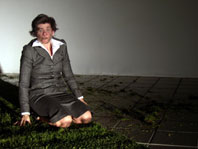 |
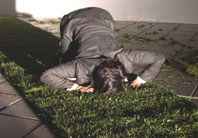 |
 |
|
|
|
